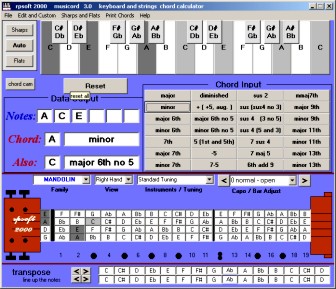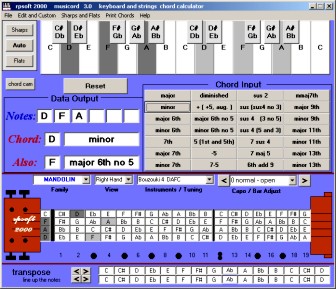| |
Forward
This page shows example usage of
rpsoft 2000 software "musicord" for mandolin "family" chord applications. To
view the main page of this software and view its main characteristics,
view it here at: musicord.
Mandolin, Bouzouki and Cittern
Chords
in the new Musicord 3.0
If you have a mandolin, cittern or
bouzouki and are looking for a chord reference for its specific tunings,
we believe that Musicord 3.0 is very much the right place to look.
Musicord 3.0 will handle string instruments of 4, 5 or 6 "courses" of
strings. By "course" we mean sets of either one string, a string
pair, or a string triplet. The actual image shows the "courses"
(fingering positions) and not all of the strings for multi-string
instruments as mandolins, bouzoukis and citterns. So an 8 string
mandolin or an 8 string bouzouki will each be displayed as a 4 string
instrument. A ten string cittern will be displayed as a five
string instrument.
Both right hand viewing and left hand
viewing is available. Also "capo" or bar fingering down the neck
or fretboard of the instrument. Many presets are available for
what we understand may be the more common tuning for mandolins,
bouzoukis and citterns. If none of these preset string tunings
work for you, Musicord also allows setting up a custom string tuning -
and even the save of a set of custom tuned stringed instruments to be
used later.
| |
 |
|
 |
|
| |
|
|
|
|
| |
The above shows the musicord screen for an
8 string (4 courses of string pairs) mandolin. It does show up
as a 4 string instrument regarding fingering positions. The
chord shown is A minor. |
|
The above shows the musicord screen
for a D minor chord for an 8 string (4 courses of string pairs)
bouzouki with DAFC tuning. Again, it would show up as a 4
string instrument regarding fingering positions. |
|
Basic Applications:
Not only will this software recognize notes to chords
or chords to note -
for 28 chord types - and also show the notes inside those chords if
wished - it also shows stringed instrument fingering down the neck of the
stringed instrument.
Chords Recognized / Created
28 chords in all,
including: major, minor, major 6th, minor 6th, 7th, major 7th,
minor 7th, mmaj7th, major 9th, minor 9th, major 11th, minor 11th, major
13th, minor 13th,diminished, augmented (also called + or +5), major 6
with no 5, minor 6th with no 5, 5, -5, 7-5, sus 2, sus (sus 4 no 3),
sus4 (3 no 5), sus 4 (5 and 3), 7 sus 4, 7 maj 5, 6th add 9.
Stored stringed instrument Presets and Tuning for Mandolin Family
(available for right or left hand viewing)
Mandolin Standard Tuning, Mandola CGDA,
Octave Mandolin GDAE, Mando - Cello CGDA, Bouzouki 1 DADA, Bouzouki 2
DGBE, Bouzouki 3 GDAE, Bouzouki 4 DAFC, Bouzouki 5 GDAD, Bouzouki 6 ADAD,
Bouzouki 7 DAEA, Bouzouki 8 ADAE, Cittern normal GDAE, Cittern Open G
DGCD, Cittern 3 DGCD, Cittern 4 ADAD, Cittern 5 ADAE, Cittern 6 DAEA,
Cittern 7 GCGC, Cittern 8 GDGD, Cittern 9 CGDAE, Cittern 10 DGDAD,
Cittern 11 DGDGD, Cittern 12 DADAD, Cittern 13 DAEAE, Cittern 14 GDAEA,
Cittern 15 GDAEB, Cittern 16 GDADA, Cittern 17 GDADG, Cittern 18 ADADA
Unique Tunings and
Storage of Favorite Tunings
If none of the above preset tunings will
work for you, Musicord also allows you to adjust each string to any
chromatic note you wish. And you can use this feature with 4
course, 5 course and 6 course stringed instruments. If you are an artist who
often uses several different tunings, you can store your custom tunings
and they will be available to you as options under the Musical Family
"Custom".
Chords to Notes
To determine the
notes in a chord such as C major, one begins by entering the C by either
pressing a C on the piano keyboard or a C on the stringed instrument fret board.
Then use the mouse pointer to select the “major” button on the chords at
the right middle of the program. The notes are then shown in the
data output. The fingering is also show on the piano and on the
stringed instrument fret board.
Fingering Options
Dark gray areas show
the primary (lowest possible) fingering. Light gray areas show
duplicate fingering that could be substituted if the person wishes. For
example, one could substitute a light gray C note fingering for a dark
gray C note fingering. Substitutes may make the fingering easier,
or make for a better sound in the particular circumstance. On the
piano, allowing different notes at the top of the chord lead to
different “inversions” of the same chord.
Options allow one to
see fingerings down the stringed instrument neck by using a “capo” option.
This option shows fingerings, four frets at a time, moving down the
neck. In this way one might find an easier, faster, or better
sounding chord fingering.
Notes to Chords
One can also enter
notes on the piano keyboard or the stringed instrument fret board, and then see if
the software program recognizes the chord. If it does, the program
will show the chord name, (piano chord or stringed instrument chord) and any
alternates, in the data area.
What if one wants to
see stringed instrument fingering for a combination of notes that are
not one of the 28 listed chords? Entering the notes on the piano
keyboard or stringed instrument fretboard will
show the note fingering on the stringed instrument fret board even if it is not one
of the 28 chords.
More Options
Even more options,
including printing, making custom tunings or instruments shown on the
main musicord page. To see these,
click here.
Relevant Links
(includes this page)
General:
Musicord Software- main page,
Left Hand Chord Example,
Retuned Strings Example
Musical Instrument
Families
Keyboard / Piano,
Guitar / Tiple,
Bass Guitar,
Ukulele,
Banjo, Mandolin / Bouzouki /
Cittern,
Violin / Fiddle / Viola / Cello,
Steel Guitar / Dobro,
Lute / Oud / Cumbus
Click Here for
eBook Info on One Person Band Recording
If you wish to Download and Try,
Click
here for the Download page. Note that you must also agree with our
rules and liability exclusion.
return
To rpsoft 2000 software
|
|